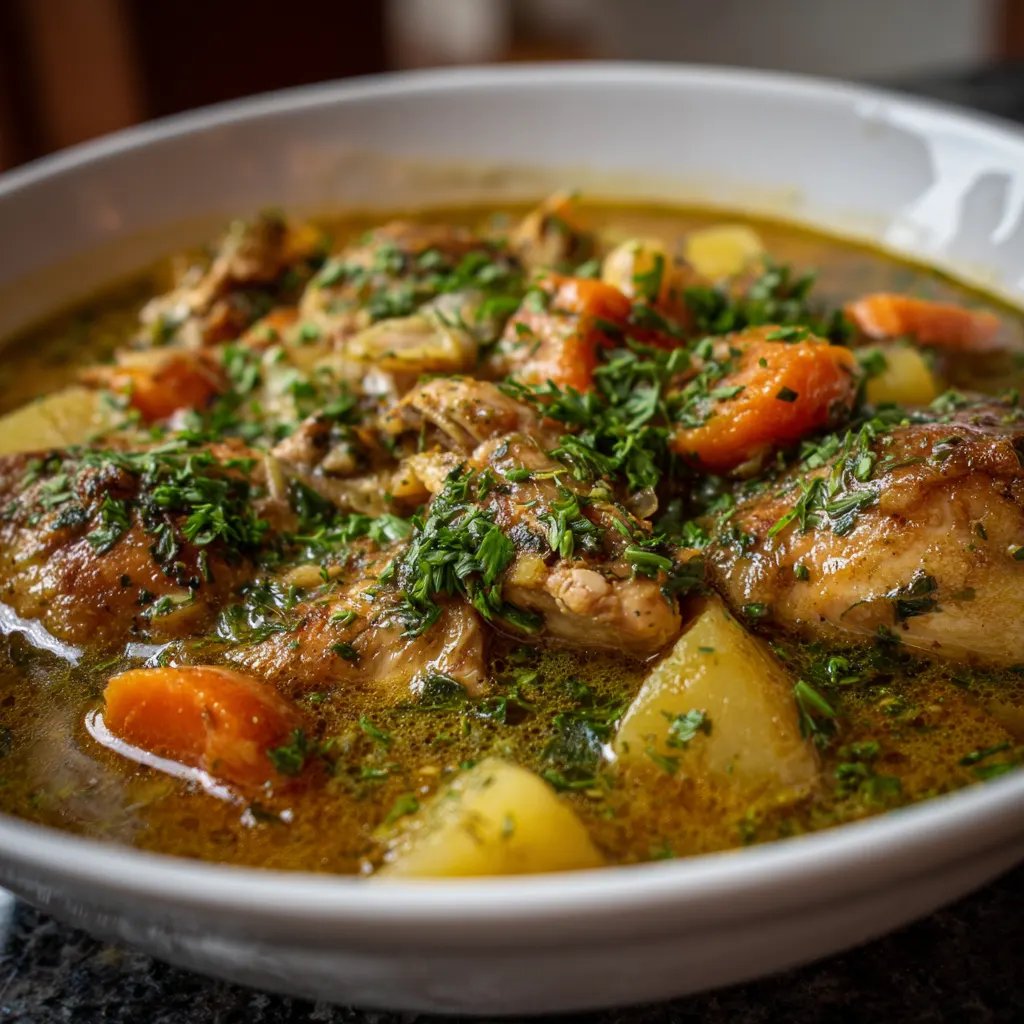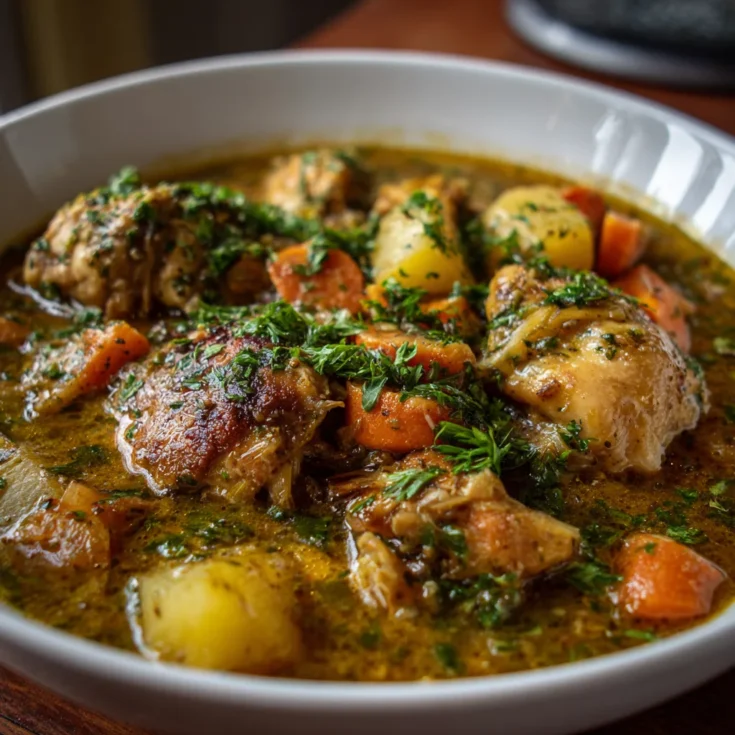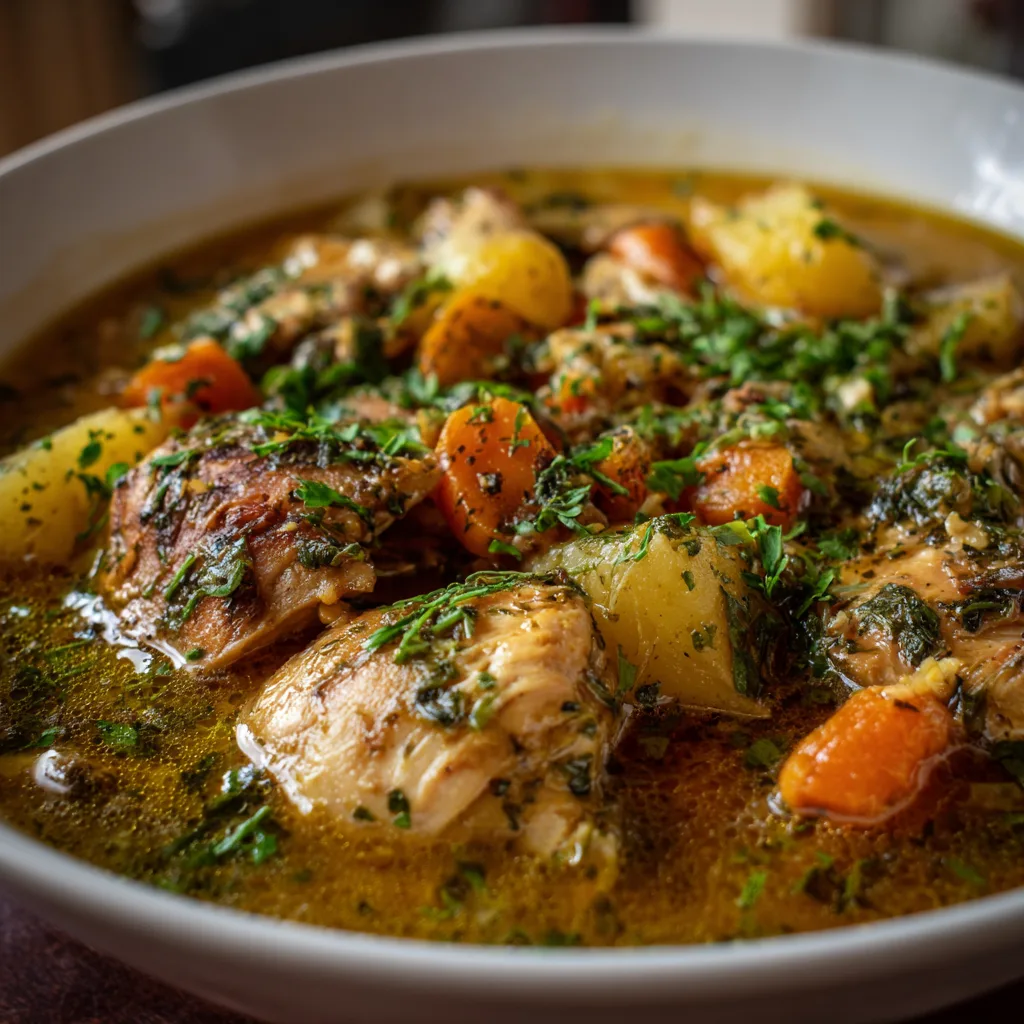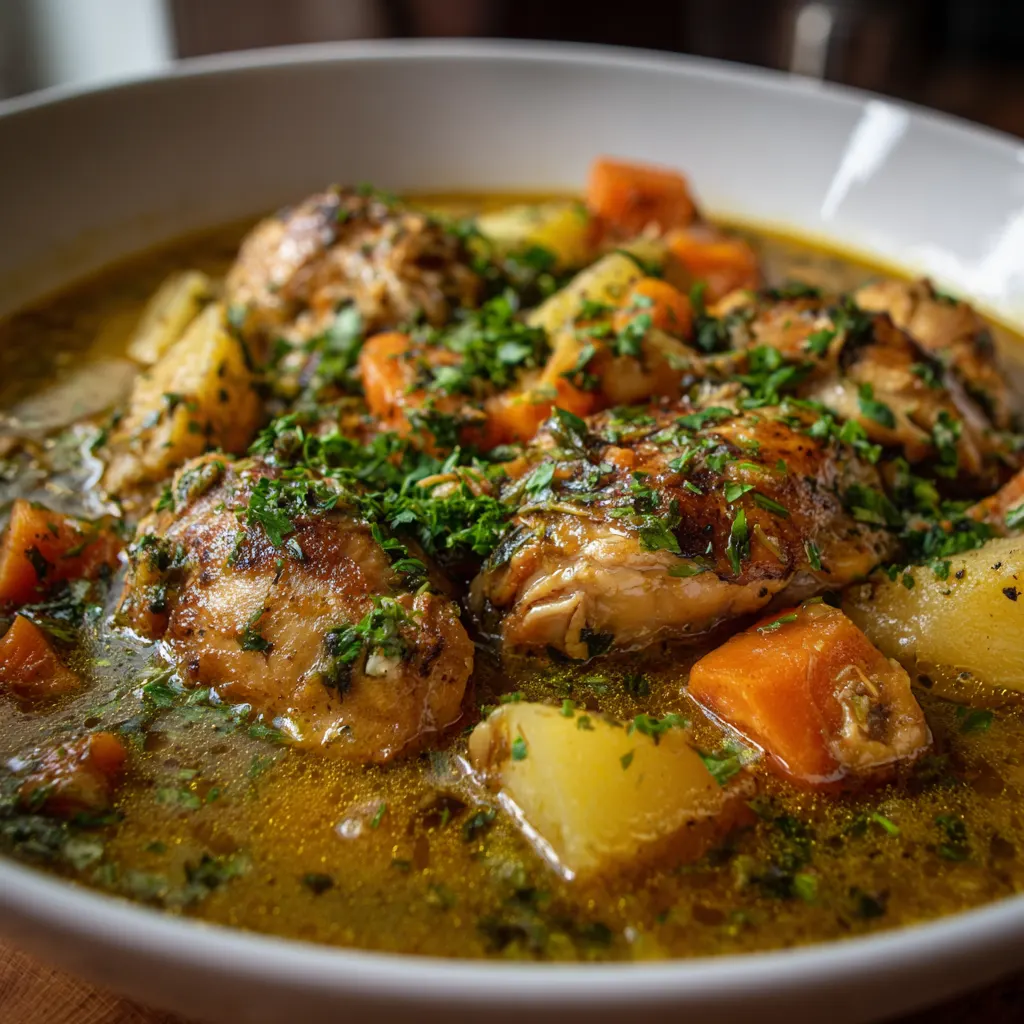Comforting Chicken Stew: A Soul‑Warming Classic
Why Chicken Stew Is the Ultimate Comfort Food
There’s something about a steaming bowl of chicken stew that speaks directly to the soul. It’s not just about the tender chicken or the hearty vegetables—it’s the feeling it brings. Chicken stew evokes warmth, safety, and memories of home. It’s a meal that wraps you in comfort on cold nights or long days. That’s what makes it timeless.
By definition, comfort food offers emotional satisfaction as much as physical nourishment. It’s often associated with nostalgia and soothing routine. According to food psychology, comfort foods activate the brain’s reward system, making us feel calmer and more connected. Chicken stew fits perfectly into this category. It’s the kind of dish you crave not just for flavor, but for the calm it brings.
Homemade and hearty, chicken stew captures what comfort food is all about—familiar, flavorful, and deeply satisfying.
What Makes a Chicken Stew Truly Comforting?
A comforting chicken stew goes beyond ingredients—it’s about how those ingredients come together. Texture matters. The chicken should be fork-tender, not dry or stringy. The vegetables—carrots, potatoes, onions—should be soft but never mushy. Together, they create a spoonful that feels complete and filling.
Flavor depth is key. A rich broth, slowly developed with herbs and aromatics, gives each bite a warm, savory base. The right seasoning brings out layers of taste—earthy, sweet, and slightly peppery. Bay leaves, thyme, and garlic are small touches that make a big difference.
This kind of stew doesn’t just feed your body—it restores your energy. It smells like home. It tastes like care. And it leaves you feeling warm from the inside out.

Core Ingredients That Bring Comfort
Why Chicken Thighs Make a Better Stew
When it comes to chicken stew, chicken thighs stand out. Unlike breast meat, thighs remain juicy after long simmering. They have more fat and connective tissue, which break down during cooking and add richness to the stew. This creates tender bites and a fuller mouthfeel.
Sources like Budget Bytes and Little Broken highlight thighs as ideal for slow-cooked recipes. They absorb flavors well and stay moist, even after an hour on the stove. Whether bone-in or boneless, chicken thighs bring depth that breast meat can’t match in hearty stews.
Hearty Vegetables Build the Foundation
The vegetables in a chicken stew are more than fillers—they bring body, sweetness, and comfort. Onion, carrot, and celery form the classic trio that lays the flavor base. Potatoes add bulk and soak up broth, while peas offer color and light sweetness.
Mushrooms deepen the umami and give a meaty bite. Turnips introduce a subtle peppery flavor that pairs well with herbs. Each vegetable brings something unique, and when combined, they create a balanced and satisfying spoonful.
Aromatics, Herbs & Seasonings
The Power of Mirepoix and Fresh Herbs
Every great chicken stew begins with aromatics. Mirepoix—a sautéed mix of onion, carrot, and celery—lays the foundation. Garlic follows to boost aroma and taste. Together, they create a base that’s earthy and familiar.
To lift the stew’s flavor, fresh or dried herbs like thyme, rosemary, oregano, and bay leaf are essential. Thyme adds depth. Rosemary brings pine-like brightness. Bay leaves tie it all together with subtle complexity. These herbs infuse the broth as it simmers, transforming simple ingredients into something memorable.
Spices That Add Personality
While herbs offer warmth, spices bring character. Paprika delivers gentle smokiness and rich color. Ground coriander adds citrusy notes. Curry powder adds warmth and complexity for those who enjoy global twists.
Mustard powder can brighten the stew with tangy heat. Cumin brings a grounded, earthy note that pairs well with both broth and vegetables. These spices can be added sparingly or boldly, depending on how adventurous the cook feels. With the right mix, even a traditional chicken stew can feel fresh and exciting.
Broth, Thickening & Add‑ins
Choosing the Right Broth for Richness
The broth is the soul of any chicken stew. A well-made chicken broth or stock brings both moisture and flavor. Homemade broth is ideal, but high-quality store-bought versions work well too.
Bone broth adds even more depth, thanks to its collagen content. It creates a silky texture and holds flavor better. Low-sodium options are best because they let you control the salt level. For richness, a splash of olive oil or a knob of butter can round things out beautifully.
Thickening for Texture and Satisfaction
To achieve the right stew texture—neither too runny nor too thick—you need a thickener. The most traditional method is a flour-based roux made by mixing flour with butter or oil. This gives a smooth, creamy finish.
For a lighter touch, a cornstarch or flour slurry can be added near the end of cooking. For gluten-free versions, rice flour or arrowroot works well. These options maintain texture without compromising flavor. The goal is a broth that coats the spoon and clings to every bite.
Step‑by‑Step Cooking Method
Browning Chicken and Building Fond
Start your stew by browning the chicken. Use a heavy-bottomed pot and heat oil over medium-high. Add chicken pieces skin-side down or flat if skinless. Let them sear without moving. This step locks in flavor and gives the chicken a golden crust.
As the chicken browns, it leaves behind rich bits on the pan’s bottom. This is called fond. It’s essential. Fond adds savory depth to the broth and boosts overall flavor. Once browned, remove the chicken and set it aside. You’ve just built your flavor base.
Sautéing Vegetables and Deglazing the Pot
With the chicken removed, it’s time to build on that base. Add onions, carrots, and celery—the classic mirepoix. Stir frequently to release their moisture and lift more fond from the pot. This builds layers of flavor in every step.
Once the vegetables soften, it’s time to deglaze. Pour in a splash of broth to loosen the browned bits stuck to the bottom. Scrape gently with a wooden spoon. This not only prevents burning but enriches the stew’s body and taste. Your stew just leveled up.
Simmering, Adjusting Heat and Timing
After deglazing, return the chicken to the pot. Add remaining broth and any herbs or spices. Bring it all to a gentle boil, then reduce to a simmer. This is where magic happens. Low, slow cooking tenderizes the chicken and deepens flavors.
Keep the pot partially covered. This allows steam to escape while keeping the stew moist. Stir occasionally and check liquid levels. Add more broth if needed. Total simmering time ranges from 30 to 45 minutes, depending on the cut of chicken and size of vegetables.
Thickening, Finishing, and Adjusting Seasoning
As the stew nears completion, check the texture. If it’s too thin, thicken it. Add a flour slurry—mix flour with cold water—or stir in a pre-made roux. Simmer uncovered for a few minutes to let it thicken naturally.
Taste and adjust the seasoning. Add salt, pepper, or a dash of lemon juice for brightness. If you like it richer, stir in cream or a knob of butter. Sources like Little Broken and Budget Bytes agree—these finishing touches elevate the stew from good to great.
One‑Pot, Slow Cooker & Instant Pot Variations
One‑Pot Stovetop Stew for Easy Cleanup
Many home cooks love the simplicity of a one-pot meal. The stovetop version keeps things tidy and flavorful. Sear the chicken, sauté the vegetables, and simmer everything in the same pot. This method locks in flavor and minimizes cleanup.
Little Broken and Cozy Cook both recommend enameled Dutch ovens or deep skillets. Everything cooks evenly, and you can serve straight from the pot. It’s ideal for weeknights or family dinners when comfort and ease matter most.
Slow Cooker or Crockpot Adaptation
Want a set-it-and-forget-it version? The slow cooker delivers. Start by searing your chicken and sautéing the vegetables in a skillet. Then transfer everything into the slow cooker. Add broth and seasonings, then cover and cook.
Set it on low for 6 to 7 hours or on high for 3 to 4. The chicken becomes fall-apart tender. The vegetables soak up flavor beautifully. According to The Cagle Diaries, this method preserves nutrients while saving time.
Instant Pot or Pressure Cooker Quick Fix
Short on time? Use an Instant Pot. First, use the sauté function to brown chicken and vegetables. Then add broth and herbs. Seal the lid and cook under pressure for 10 minutes. Let it release naturally for 10 more. Quick, rich, and ready in under 30 minutes.
International & Cultural Twists
Creamy Chicken Stew (Gluten-Free Option)
Prefer a creamier version? Stir in heavy cream or coconut milk near the end. Play’s Well With Butter offers a gluten-free creamy chicken stew that feels decadent without the wheat. It’s velvety, rich, and still easy to digest.
Tomato-Based Filipino Stews
In Filipino cuisine, kinamatisang manok uses tomatoes and leafy greens to create a tangy, rustic stew. Ginataang manok replaces the acidity with creamy coconut milk and chili. Both are comforting takes with bold flavor.
Peruvian Ají de Gallina
This creamy yellow chicken stew from Peru features shredded chicken in a spicy, cheesy sauce thickened with bread or crackers. Often served with rice and olives, ají de gallina offers bold flavor and a unique twist on comfort food.
Nigerian Spicy Tomato Chicken Stew
A staple in West African homes, Nigerian chicken stew blends tomatoes, onions, chili, and fragrant spices. It’s bold, spicy, and soul-satisfying. Often served with rice or plantains, this dish proves that comfort food is a global concept.
Customizing Chicken Stew for Diet & Taste
Chicken stew adapts easily to fit many diets and flavor preferences. For gluten-free needs, simply replace wheat flour with rice flour or cornstarch as a thickener. These alternatives thicken the broth without changing the taste or texture.
Dairy-free cooks can skip cream and butter altogether. Instead, use olive oil or coconut milk for richness. This keeps the stew creamy while avoiding dairy allergens.
If you want to reduce sodium, choose low-sodium broth or make your own. Season gradually to control salt levels. This approach keeps the flavors balanced and heart-healthy.
Vegetarians can enjoy stew by swapping chicken for hearty beans, lentils, or mushrooms. These ingredients add protein and texture while soaking up the stew’s rich broth. Adding root vegetables like sweet potatoes or parsnips creates a filling, plant-based alternative that comforts just as well.
Comforting Chicken Stew – Easy One-Pot Family Dinner

A hearty, soul-warming chicken stew loaded with tender chicken and root vegetables in a rich, flavorful broth—perfect for chilly nights.
Ingredients
- 2 lbs boneless, skinless chicken thighs
- 2 tbsp olive oil
- 1 tbsp butter (optional for richness)
- 1 large onion, diced
- 2 carrots, peeled and chopped
- 2 celery stalks, chopped
- 3 cloves garlic, minced
- 3 medium potatoes (Yukon gold or russet), peeled and cubed
- 3 tbsp all-purpose flour or rice flour for gluten-free
- 4 cups chicken broth (low sodium preferred)
- 1 tsp dried thyme
- 1 bay leaf
- Salt and pepper to taste
- Optional: 1 cup peas, mushrooms, or a splash of cream for finishing
Instructions
▢ Pat chicken dry and season with salt and pepper. Brown in hot olive oil and butter over medium-high heat until golden. Remove and set aside.
▢ In the same pot, sauté onion, carrot, celery, and garlic until softened and fragrant.
▢ Deglaze the pot with a splash of chicken broth, scraping up browned bits. Stir in flour slurry (flour mixed with cold water).
▢ Return chicken to pot, add remaining broth, herbs, and bay leaf. Simmer gently for 25–30 minutes.
▢ Add potatoes and peas; cook until vegetables are tender, about 15 minutes.
▢ Remove bay leaf. Finish with cream or fresh parsley if desired. Adjust seasoning with salt and pepper.
▢ Serve warm with crusty bread or rice.
Notes
– Chicken thighs stay tender; breasts cook faster but risk drying out.
– For a thicker stew, simmer uncovered or whisk in extra slurry.
– Freeze leftovers in portions; reheat gently and add broth as needed to restore consistency.
Flavor Variants to Explore in Chicken Stew
Chicken stew lends itself to exciting global twists. Try a peanut stew inspired by West African flavors, where creamy peanut butter adds depth and a hint of sweetness. This variation is both rich and satisfying.
A coconut curry style brings warm spices and coconut milk together for a stew with vibrant color and bold flavor. This variation pairs well with rice and fresh cilantro.
Moroccan tagine-style stew combines spices like cumin, cinnamon, and turmeric with preserved lemons and olives. The result is a fragrant, slightly tangy dish that delights the palate.
For added heartiness, consider dumplings. Soft, pillowy dumplings cooked right in the stew soak up its delicious broth. Alternatively, add beans or leafy greens like kale or spinach to boost nutrition and texture.
These variations keep the comforting spirit of chicken stew alive while introducing new tastes and textures for adventurous eaters.

FAQ About Chicken Stew
Can I make this stew in a crock-pot?
Yes. Browning chicken first develops flavor. After sautéing vegetables, transfer everything to the slow cooker. Cook on high for 4–6 hours.
What herbs go well with chicken stew?
Common herbs include rosemary, thyme, oregano, basil, parsley, and bay leaf. These add warmth and depth.
How can I make the stew taste richer?
Add umami boosters like soy sauce or Worcestershire sauce. Finish with cream, butter, a splash of vinegar, or lemon juice. Extra sautéed aromatics also help.
Can you overcook chicken stew?
Yes. Overcooking leads to dry, stringy chicken. Simmer just until chicken is tender and cooked through.
What not to put in a stew?
Avoid delicate greens and zucchini early on—they overcook and turn mushy. Also, cornstarch is less ideal than a flour-based thickener like a roux or slurry.


